
The Araceae are a family of monocotyledonous flowering plants in which flowers are borne on a type of inflorescence called a spadix. The spadix is usually accompanied by, and sometimes partially enclosed in, a spathe. Also known as the arum family, members are often colloquially known as aroids. This family of 114 genera and about 3,750 known species is most diverse in the New World tropics, although also distributed in the Old World tropics and northern temperate regions.

Arisaema is a large and diverse genus of the flowering plant family Araceae.
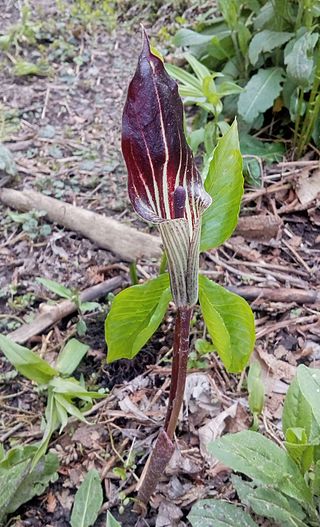
Arisaema triphyllum, the Jack-in-the-pulpit, is a species of flowering plant in the arum family Araceae. It is a member of the Arisaema triphyllum complex, a group of four or five closely related taxa in eastern North America. The specific name triphyllum means "three-leaved", a characteristic feature of the species, which is also referred to as Indian turnip, bog onion, and brown dragon.

Calla is a genus of flowering plant in the family Araceae, containing the single species Calla palustris.

Phellodendron amurense is a species of tree in the family Rutaceae, commonly called the Amur cork tree. It is a major source of huáng bò, one of the 50 fundamental herbs used in traditional Chinese medicine. The Ainu people used this plant, called shikerebe-ni, as a painkiller. It is known as hwangbyeok in Korean and (キハダ) kihada in Japanese.
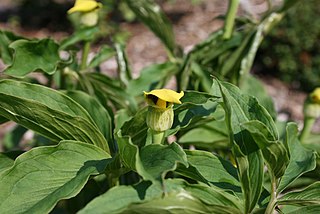
Arisaema flavum is a species of flowering plant widespread across north-eastern Africa and southern Asia. It is native to Ethiopia, Somalia, the Arabian Peninsula, Pakistan, Afghanistan, Nepal, Assam, Himalayas, Tibet, Yunnan, and Sichuan. The species epithet flavum is Latin for yellow and indicates its flower colour.
Hiroyoshi Ohashi is a botanist formerly at the University of Tokyo and Tohoku University. He began publishing on Japanese Arisaema in the early 1960s. He published a couple of miscellaneous notes on Arisaema in 1963 and 1964 and these were followed by a revision of the genus for Japan jointly published in 1980 with J. Murata, and by the Araceae treatment for the Wildflowers of Japan.

Arisaema candidissimum is a species of flowering plant in the arum family (Araceae), originating in western China. Various English names have been given to the species, including Chinese cobra lily and Chinese jack-in-the-pulpit. The Chinese name is 白苞南星.

Arisaema quinatum is a species of flowering plant in the arum family Araceae. It is a member of the Arisaema triphyllum complex, a group of closely related taxa in eastern North America. The specific name quinatum means "divided into five lobes", a reference to its characteristic leaves. It is commonly known as the southern Jack-in-the-pulpit but some refer to it as Preacher John.
Arisaema pusillum is a species of flowering plant in the arum family Araceae. It is a member of the Arisaema triphyllum complex, a group of closely related taxa in eastern North America. The specific name pusillum, which means "very small, slender", describes the overall size of the plant relative to that of the more common Arisaema triphyllum. It is commonly known as the small Jack-in-the-pulpit. It is sometimes referred to as the swamp Jack, not to be confused with Arisaema stewardsonii, which is also known by that name.
Arisaema stewardsonii is a species of flowering plant in the arum family Araceae. It is a member of the Arisaema triphyllum complex, a group of closely related taxa in eastern North America. The specific name stewardsonii honors American botanist Stewardson Brown (1867–1921). It is commonly known as the bog Jack-in-the-pulpit. It is sometimes referred to as the swamp Jack-in-the-pulpit, not to be confused with Arisaema pusillum, which is also known by that name.
Arisaema acuminatum is a species of flowering plant in the arum family Araceae. It is a member of the Arisaema triphyllum complex, a group of closely related taxa in eastern North America. The specific name acuminatum means "with a long, narrow and pointed tip", which describes the shape of the spathe hood. The species is commonly known as the Florida Jack-in-the-pulpit.

Arisaema speciosum is a species of flowering plant in the family Araceae, native to Nepal, East Himalaya, Assam, Tibet and south-central China.
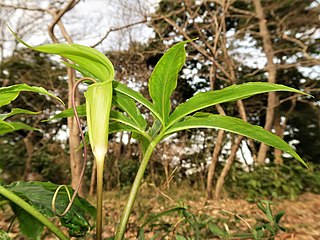
Arisaema section Clavata is a section of the genus Arisaema.
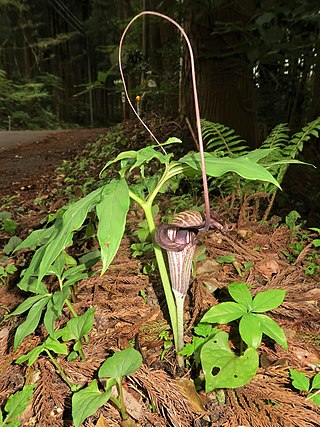
Arisaema section Flagellarisaema is a section of the genus Arisaema.
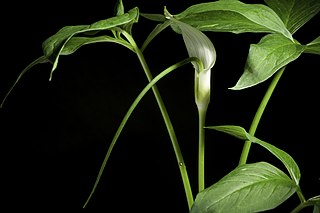
Arisaema section Odorata is a section of the genus Arisaema. This section was described in 2013 in "A nomenclatural review on the infrageneric classification of Arisaema (Araceae)" in the Journal of Japanese Botany.

Arisaema section Nepenthoidea is a section of the genus Arisaema.

Arisaema section Attenuata is a section of the genus Arisaema found in tropical and subtropical habitats.
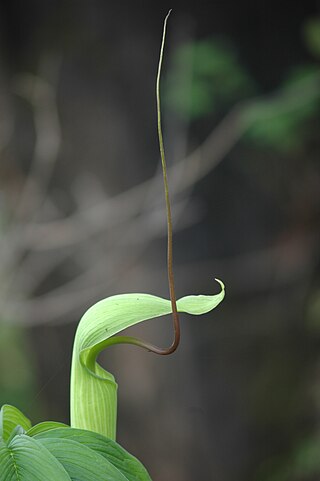
Arisaema section Tortuosa is a section of the genus Arisaema.

Arisaema ringens, the Japanese cobra lily, is a species of flowering plant in the family Araceae, native to the Zhoushan Islands of China, Taiwan, South Korea, central Japan, and the Ryukyu Islands. A tuberous geophyte reaching 45 cm (18 in), in the wild they are found at low elevations in forests. A dioecious species, it is pollinated by flies. In the garden it needs moist, humus-rich soil, and is hardy in USDA zones 6 through 9.



















